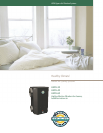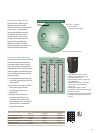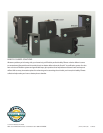
33
HEPA Filtration System Specifications
HEPA20 HEPA40 HEPA60
Airflow (nominal) at 120 VAC 180 CFM 250 CFM 500 CFM
Power Consumption (nominal) 125 watts 125 watts 225 watts
MERV 6 Prefilter Life 12 mos. 12 mos. 12 mos.
Carbon Canister Life (optional accessory) 6 mos. 6 mos. 6 mos.
HEPA Filter Life (min.) 2-5 years
†
2-5 years
†
2-5 years
†
†
Will vary based on the severity of the environment.
Note: Due to ongoing commitment to quality, all specifications, ratings and dimensions are subject to change without notice.
Near-perfect particle filtration
Healthy Climate
®
HEPA bypass
filtration systems are 99.97%
efficient at removing small particles
at 0.3 micron—contaminants
that standard filtration systems
can’t effectively stop. Particles
smaller than 2.5 microns pass
through the lungs and into the
bloodstream, increasing the
likelihood of illness. The HEPA
system minimizes your exposure to
potentially harmful pollutants.
Source: Pennsylvania State University
One micron = 1/25,000 of
an inch in diameter
Scale: Approximately 8000:1
Pollen
100 microns
Spore
10 microns
Virus
0.01 micron
Bacteria
1 micron
Respirable Particles and Bioaerosols
“True” HEPA filter media – 99.97%
efficient at 0.3 micron in removing
particles and bioaerosols
Optional carbon canister – Helps trap
and remove odors
Fast, effective cleaning – Completely
filters the air in your home many
times a day
Sealed, bypass design – Retains
particles and keeps them from escaping
Low operating costs
Insulated cabinet prevents condensation
ASTM E981 tested to be free of sensory
irritancy
HEPA FILTRATION PROCESS
Prefilter
HEPA
Filter
Optional
Carbon Filter
Odors/Fumes
Powerful, yet quiet, performance
The system acts like a vacuum, drawing
air out of the return duct, cleaning
it and then cycling it back into your
home. The system can also operate
independently of your HVAC system to
isolate and filter a specific area of your
home. The filtration process involves
three main steps:
1) Contaminated air passes through
a pre-filter, trapping large dirt and
dust particles.
2) Air then flows through the HEPA
filter, which captures nearly
all remaining particles and
bioaerosols.
3) Finally, air passes through a
charcoal/carbon filter in the
standard unit to absorb odors
and chemical fumes. An optional
carbon canister is available for
enhanced absorption.






